Combining the Monthly Drought Code and Paleoecological Data to Assess Holocene Climate Impact on Mediterranean Fire Regime
Abstract
1. Introduction
2. Materials and Methods
2.1. Study Area and Sampled Lakes
2.2. Charcoal, Pollen, and Fungal Remains Analyses
2.3. Current Climate and Fire Datasets
2.4. Climatic Model
2.5. Fire Weather Index System
2.6. Fire Season Length
3. Results
3.1. DC and MDC Efficiently Detect Fire Days/Months of the Current Period (1979–2016)
3.2. Change in MDC and FSL during the Holocene
3.3. Holocene Paleofire and Environmental Changes from Lacustrine Sediment Reconstructions
4. Discussion
4.1. The Efficiency of DC and MDC to Target Potential Fire-Days/Months and Assess the Fire-Season Length
4.2. Holocene History: From Climatic to Anthropogenic Fires
4.3. The Current Climate Is Getting Close to the Mid-Holocene Climate Conditions
4.4. Limitations of the Study
5. Conclusions
Author Contributions
Funding
Acknowledgments
Conflicts of Interest
Appendix A
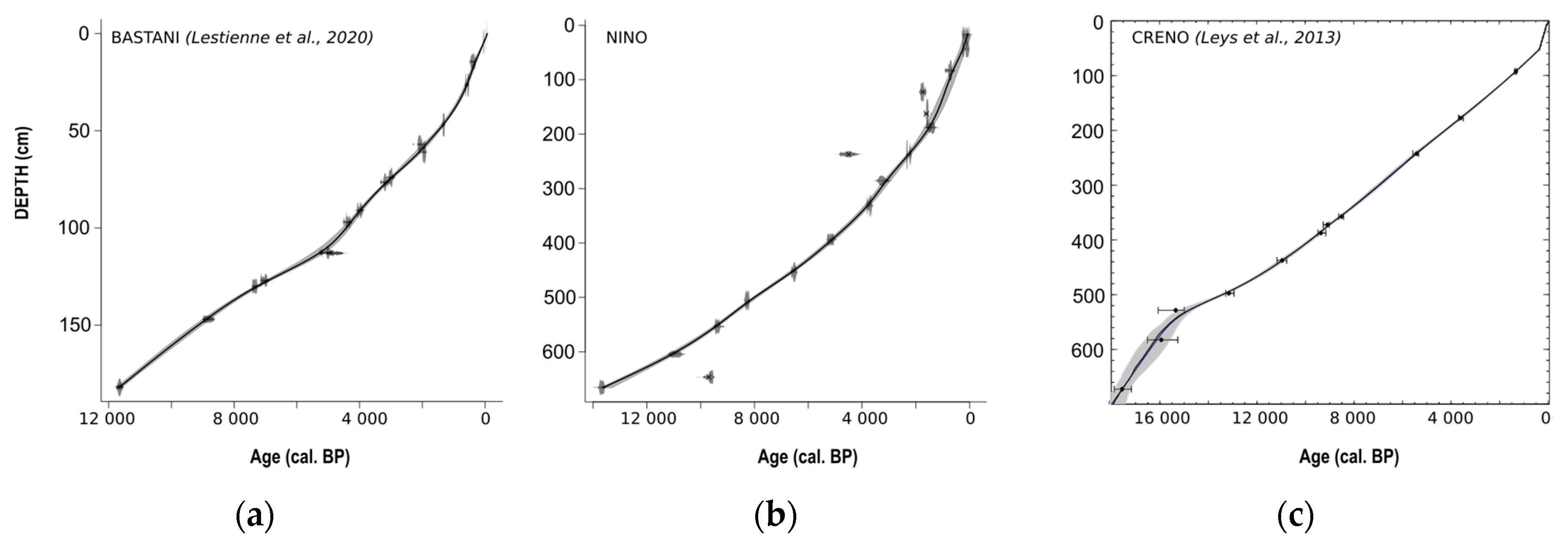
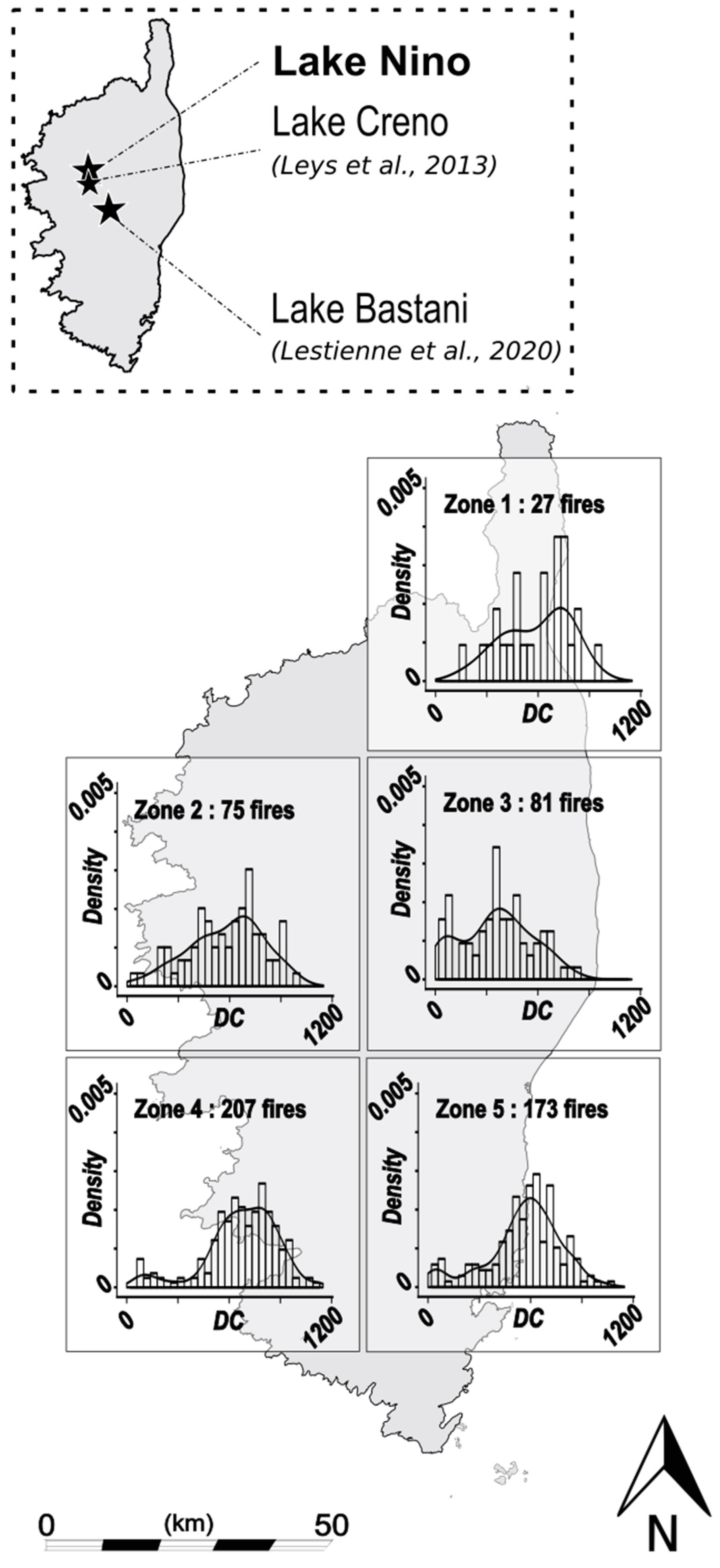

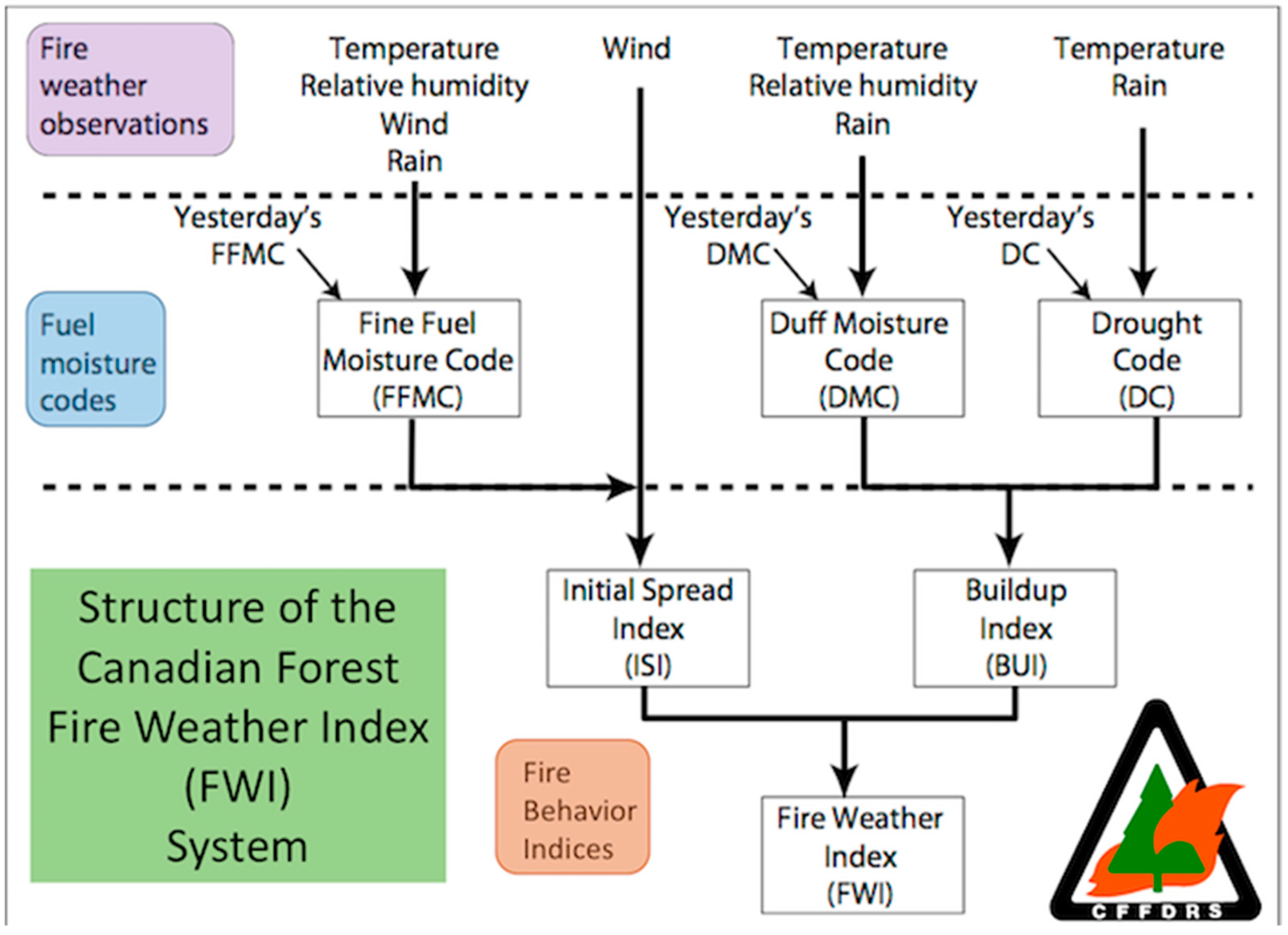
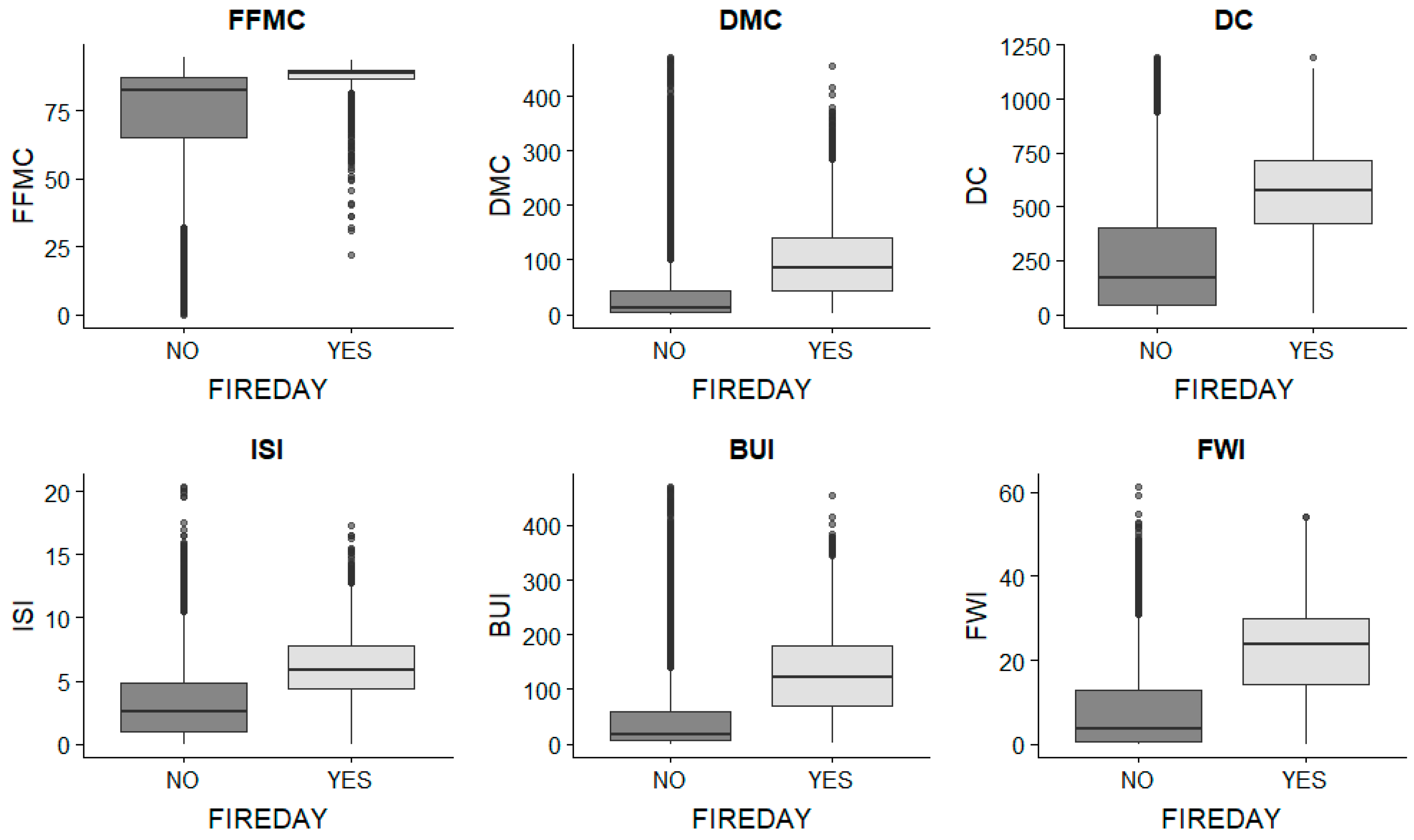

References
- Bürger, G. Evaluation of the Monthly Drought Code as a Metric for Fire Weather in a Region of Complex Terrain and Un-Certainties in Future Projections; Pacific Climate Impacts Consortium: Victoria, BC, Canada, 2013. [Google Scholar]
- Pausas, J.G.; Llovet, J.; Rodrigo, A.; Vallejo, R. Are wildfires a disaster in the Mediterranean basin?—A review. Int. J. Wildland Fire 2009, 17, 713–723. [Google Scholar] [CrossRef]
- Pausas, J.G.; Ribeiro, E. Fire and plant diversity at the global scale. Glob. Ecol. Biogeogr. 2017, 26, 889–897. [Google Scholar] [CrossRef]
- Pausas, J.G.; Vallejo, V.R. The Role of Fire in European Mediterranean Ecosystems. In Proceedings of the Remote Sensing of Large Wildfires; Springer: Berlin/Heidelberg, Germany, 1999; pp. 3–16. [Google Scholar]
- Whelan, R.J. The Ecology of Fire; Cambridge Studies in Ecology; Cambridge University Press: Cambridge, UK; New York, NY, USA, 1995. [Google Scholar]
- Pausas, J.G. Changes in fire and climate in the eastern Iberian Peninsula (Mediterranean basin). Clim. Chang. 2004, 63, 337–350. [Google Scholar] [CrossRef]
- Sá, A.C.L.; Benali, A.; Fernandes, P.M.; Pinto, R.M.S.; Trigo, R.M.; Salis, M.; Russo, A.; Jerez, S.; Soares, P.M.M.; Schroeder, W.; et al. Evaluating fire growth simulations using satellite active fire data. Remote Sens. Environ. 2017, 190, 302–317. [Google Scholar] [CrossRef]
- Keeley, J.E. Fire intensity, fire severity and burn severity: A brief review and suggested usage. Int. J. Wildland Fire 2009, 18, 116. [Google Scholar] [CrossRef]
- Leys, B.; Finsinger, W.; Carcaillet, C. Historical range of fire frequency is not the Achilles’ heel of the Corsican black pine ecosystem. J. Ecol. 2014, 102, 381–395. [Google Scholar] [CrossRef]
- Prométhée. Available online: http://www.promethee.com/ (accessed on 7 November 2016).
- Bradstock, R.A. A biogeographic model of fire regimes in Australia: Current and future implications. Glob. Ecol. Biogeogr. 2010, 19, 145–158. [Google Scholar] [CrossRef]
- Vannière, B.; Colombaroli, D.; Chapron, E.; Leroux, A.; Tinner, W.; Magny, M. Climate versus human-driven fire regimes in Mediterranean landscapes: The Holocene record of Lago dell’Accesa (Tuscany, Italy). Quat. Sci. Rev. 2008, 27, 1181–1196. [Google Scholar] [CrossRef]
- Blarquez, O.; Ali, A.A.; Girardin, M.P.; Grondin, P.; Fréchette, B.; Bergeron, Y.; Hély, C. Regional paleofire regimes affected by non-uniform climate, vegetation and human drivers. Sci. Rep. 2015, 5, 13356. [Google Scholar] [CrossRef]
- Westerling, A.L.; Hidalgo, H.G.; Cayan, D.R.; Swetnam, T.W. Warming and earlier spring increase western US forest wildfire activity. Science 2006, 313, 940–943. [Google Scholar] [CrossRef]
- Flannigan, M.D.; Stocks, B.J.; Wotton, B.M. Climate change and forest fires. Sci. Total Environ. 2000, 262, 221–229. [Google Scholar] [CrossRef]
- Hennessy, K.; Lucas, C.; Nicholls, N.; Bathols, J.; Suppiah, R.; Ricketts, J. Climate Change Impacts on Fire-Weather in South-East Australia; CSIRO: Canberra, Australia, 2005.
- Price, C.; Rind, D. Possible implications of global climate change on global lightning distributions and frequencies. J. Geophys. Res. Atmos. 1994, 99, 10823–10831. [Google Scholar] [CrossRef]
- Bond, W.J.; Keeley, J.E. Fire as a global ‘herbivore’: The ecology and evolution of flammable ecosystems. Trends Ecol. Evol. 2005, 20, 387–394. [Google Scholar] [CrossRef] [PubMed]
- Pausas, J.G.; Paula, S. Fuel shapes the fire–climate relationship: Evidence from Mediterranean ecosystems. Glob. Ecol. Biogeogr. 2012, 21, 1074–1082. [Google Scholar] [CrossRef]
- Ganteaume, A.; Camia, A.; Jappiot, M.; San-Miguel-Ayanz, J.; Long-Fournel, M.; Lampin, C. A Review of the Main Driving Factors of Forest Fire Ignition Over Europe. Environ. Manag. 2013, 51, 651–662. [Google Scholar] [CrossRef] [PubMed]
- Fréjaville, T.; Curt, T. Spatiotemporal patterns of changes in fire regime and climate: Defining the pyroclimates of south-eastern France (Mediterranean Basin). Clim. Chang. 2015, 129, 239–251. [Google Scholar] [CrossRef]
- Curt, T.; Fréjaville, T.; Lahaye, S. Modelling the spatial patterns of ignition causes and fire regime features in southern France: Implications for fire prevention policy. Int. J. Wildland Fire 2016, 25, 785. [Google Scholar] [CrossRef]
- Van Wagner, C.E. Development and Structure of the Canadian Forest Fire Weather Index System; Forestry Technical Report; Canadian Forestry Service: Ottawa, ON, Canada, 1987; pp. 35–37.
- Aguado, I.; Chuvieco, E.; Martin, P.; Salas, J. Assessment of forest fire danger conditions in southern Spain from NOAA images and meteorological indices. Int. J. Remote Sens. 2003, 24, 1653–1668. [Google Scholar] [CrossRef]
- Carvalho, A.; Flannigan, M.D.; Logan, K.; Miranda, A.I.; Borrego, C. Fire activity in Portugal and its relationship to weather and the Canadian Fire Weather Index System. Int. J. Wildland Fire 2008, 17, 328–338. [Google Scholar] [CrossRef]
- Moriondo, M.; Good, P.; Durao, R.; Bindi, M.; Giannakopoulos, C.; Corte-Real, J. Potential impact of climate change on fire risk in the Mediterranean area. Clim. Res. 2006, 31, 85–95. [Google Scholar] [CrossRef]
- Viegas, D.X.; Bovio, G.; Ferreira, A.; Nosenzo, A.; Sol, B. Comparative study of various methods of fire danger evaluation in southern Europe. Int. J. Wildland Fire 1999, 9, 235–246. [Google Scholar] [CrossRef]
- Girardin, M.P.; Wotton, B.M. Summer moisture and wildfire risks across Canada. J. Appl. Meteorol. Climatol. 2009, 48, 517–533. [Google Scholar] [CrossRef]
- Pachauri, R.K.; Reisinger, A. IPCC Fourth Assessment Report; IPCC: Geneva, Switzerland, 2007. [Google Scholar]
- Joussaume, S.; Taylor, K.E. Status of the Paleoclimate Modeling Intercomparison Project (PMIP); World Meteorological Organization Publications: Geneva, Switzerland, 1995; pp. 425–430. [Google Scholar]
- Hodges, K.I. Spherical Nonparametric Estimators Applied to the UGAMP Model Integration for AMIP. Mon. Weather Rev. 1996, 124, 2914–2932. [Google Scholar] [CrossRef]
- Dee, D.P.; Uppala, S.M.; Simmons, A.J.; Berrisford, P.; Poli, P.; Kobayashi, S.; Andrae, U.; Balmaseda, M.A.; Balsamo, G.; Bauer, P.; et al. The ERA-Interim reanalysis: Configuration and performance of the data assimilation system. Q. J. R. Meteorol. Soc. 2011, 137, 553–597. [Google Scholar] [CrossRef]
- Lestienne, M.; Jouffroy-Bapicot, I.; Leyssenne, D.; Sabatier, P.; Debret, M.; Albertini, P.-J.; Colombaroli, D.; Hély, C.; Vannière, B. Fires and human activities as key factors of the high diversity of Corsican vegetation. Holocene 2020, 30, 244–257. [Google Scholar] [CrossRef]
- Médail, F.; Verlaque, R. Ecological characteristics and rarity of endemic plants from southeast France and Corsica: Implications for biodiversity conservation. Biol. Conserv. 1997, 80, 269–281. [Google Scholar] [CrossRef]
- Finsinger, W.; Colombaroli, D.; De Beaulieu, J.-L.; Valsecchi, V.; Vannière, B.; Vescovi, E.; Chapron, E.; Lotter, A.F.; Magny, M.; Tinner, W. Early to mid-Holocene climate change at Lago dell’Accesa (central Italy): Climate signal or anthropogenic bias? J. Quat. Sci. 2010, 25, 1239–1247. [Google Scholar] [CrossRef]
- Keeley, J.E.; Zedler, P.H. Large, high-intensity fire events in southern California shrublands: Debunking the fine-grain age patch model. Ecol. Appl. 2009, 19, 69–94. [Google Scholar] [CrossRef]
- Pausas, J.G.; Fernández-Muñoz, S. Fire regime changes in the Western Mediterranean Basin: From fuel-limited to drought-driven fire regime. Clim. Chang. 2012, 110, 215–226. [Google Scholar] [CrossRef]
- Leys, B. Facteurs Explicatifs de la Dynamique des Végétations au Cours de l’Holocène en Système Montagnard Méditerranéen et al. Pin: Climat et Perturbation Feu; EPHE: Paris, France, 2012. [Google Scholar]
- Conchon, O. Quaternary glaciations in Corsica. Quat. Sci. Rev. 1986, 5, 429–432. [Google Scholar] [CrossRef]
- Reille, M.; Gamisans, J.; Andrieu-Ponel, V.; De Beaulieu, J.-L. The Holocene at Lac de Creno, Corsica, France: A key site for the whole island. New Phytol. 1999, 141, 291–307. [Google Scholar] [CrossRef]
- Reille, M. New pollen-analytical researches in Corsica: The problem of Quercus ilex L. and Erica arborea L., the origin of Pinus halepensis Miller forests. New Phytol. 1992, 122, 359–378. [Google Scholar] [CrossRef]
- Leys, B.; Carcaillet, C.; Dezileau, L.; Ali, A.A.; Bradshaw, R.H.W. A comparison of charcoal measurements for reconstruction of Mediterranean paleo-fire frequency in the mountains of Corsica. Quat. Res. 2013, 79, 337–349. [Google Scholar] [CrossRef]
- Gauthier, A.; Roche, B.; Frisoni, G.-F. Contribution à la Connaissance des Lacs d’Altitudes de Corse; Parc Naturel Regional de la Corse: Corte, France, 1983. [Google Scholar]
- Conchon, O. Manifestation et chronologie de la déglaciation fini-würmiennne en Corse. Quaternaire 1988, 25, 91–96. [Google Scholar] [CrossRef]
- Roche, B.; Loye-Pilot, M.D. Eutrophisation récente d’un lac de montagne sans occupation humaine (lac de Bastani, Corset: Conséquence d’agents atmosphériques? J. Water Sci. 1989, 2, 681–707. [Google Scholar] [CrossRef]
- Rhodes, A.N. A method for the preparation and quantification of microscopic charcoal from terrestrial and lacustrine sediment cores. Holocene 1998, 8, 113–117. [Google Scholar] [CrossRef]
- Whitlock, C.; Larsen, C. Charcoal as a Fire Proxy. In Tracking Environmental Change Using Lake Sediments; Springer: Berlin/Heidelberg, Germany, 2002; pp. 75–97. [Google Scholar]
- Favre, E.; Escarguel, G.; Suc, J.-P.; Vidal, G.; Thévenod, L. A contribution to deciphering the meaning of AP/NAP with respect to vegetation cover. Rev. Palaeobot. Palynol. 2008, 148, 13–35. [Google Scholar] [CrossRef]
- Li, Y.; Zhou, L.; Cui, H. Pollen indicators of human activity. Chin. Sci. Bull. 2008, 53, 1281. [Google Scholar] [CrossRef]
- Baker, A.; Bhagwat, S.; Willis, K. Do dung fungal spores make a good proxy for past distribution of herbivores? Quat. Sci. Rev. 2013, 62, 21–31. [Google Scholar] [CrossRef]
- Prométhée2: Forest Fires Database for Mediterranean Area in France. Available online: https://www.promethee.com/en (accessed on 1 September 2019).
- Valdes, P.J.; Armstrong, E.; Badger, M.P.S.; Bradshaw, C.D.; Bragg, F.; Crucifix, M.; Davies-Barnard, T.; Day, J.J.; Farnsworth, A.; Gordon, C.; et al. The BRIDGE HadCM3 family of climate models: HadCM3@Bristol v1.0. Geosci. Model Dev. 2017, 10, 3715–3743. [Google Scholar] [CrossRef]
- Bragg, F.J.; Lunt, D.J.; Haywood, A.M. Mid-Pliocene climate modelled using the UK Hadley Centre Model: PlioMIP Experiments 1 and 2. Geosci. Model Dev. 2012, 5, 1109–1125. [Google Scholar] [CrossRef]
- Gordon, C.; Cooper, C.; Senior, C.A.; Banks, H.; Gregory, J.M.; Johns, T.C.; Mitchell, J.F.B.; Wood, R.A. The simulation of SST, sea ice extents and ocean heat transports in a version of the Hadley Centre coupled model without flux adjustments. Clim. Dyn. 2000, 16, 147–168. [Google Scholar] [CrossRef]
- Ramstein, G.; Kageyama, M.; Guiot, J.; Wu, H.; Hély, C.; Krinner, G.; Brewer, S. How cold was Europe at the Last Glacial Maximum? A synthesis of the progress achieved since the first PMIP model-data comparison. Clim. Past 2007, 3, 331–339. [Google Scholar] [CrossRef]
- Hély, C.; Girardin, M.P.; Ali, A.A.; Carcaillet, C.; Brewer, S.; Bergeron, Y. Eastern boreal North American wildfire risk of the past 7000 years: A model-data comparison. Geophys. Res. Lett. 2010, 37. [Google Scholar] [CrossRef]
- Stocks, B.J.; Lynham, T.J.; Lawson, B.D.; Alexander, M.E.; Wagner, C.E.V.; McAlpine, R.S.; Dubé, D.E. Canadian Forest Fire Danger Rating System: An Overview. For. Chron. 1989, 65, 258–265. [Google Scholar] [CrossRef]
- Thornthwaite, C.W.; Mather, J.R. The Water Budget Ami Its Use in Irrigation. Available online: https://naldc.nal.usda.gov/download/IND43894582/PDF (accessed on 1 September 2019).
- Brewer, S.; Alleaume, S.; Guiot, J.; Nicault, A. Historical droughts in Mediterranean regions during the last 500 years: A data/model approach. Clim. Past 2007, 3, 355–366. [Google Scholar] [CrossRef]
- Dimitrakopoulos, A.P.; Bemmerzouk, A.M.; Mitsopoulos, I.D. Evaluation of the Canadian fire weather index system in an eastern Mediterranean environment. Meteorol. Appl. 2011, 18, 83–93. [Google Scholar] [CrossRef]
- Camia, A.; Amatulli, G. Weather Factors and Fire Danger in the Mediterranean. In Earth Observation of Wildland Fires in Mediterranean Ecosystems; Springer: Berlin/Heidelberg, Germany, 2009; pp. 71–82. [Google Scholar]
- Bedia, J.; Herrera, S.; Camia, A.; Moreno, J.M.; Gutiérrez, J.M. Forest fire danger projections in the Mediterranean using ENSEMBLES regional climate change scenarios. Clim. Chang. 2014, 122, 185–199. [Google Scholar] [CrossRef]
- Lahaye, S.; Curt, T.; Fréjaville, T.; Sharples, J.; Paradis, L.; Hély, C. What are the drivers of dangerous fires in Mediterranean France? Int. J. Wildland Fire 2018, 27, 155–163. [Google Scholar] [CrossRef]
- Ruffault, J.; Curt, T.; St-Paul, N.M.; Moron, V.; Trigo, R.M. Extreme Wildfire occurrence in response to Global Change type Droughts in the Northern Mediterranean. Nat. Hazards Earth Syst. Sci. 2017, 1–21. [Google Scholar] [CrossRef]
- Ruffault, J.; Moron, V.; Trigo, R.M.; Curt, T. Daily synoptic conditions associated with large fire occurrence in Mediterranean France: Evidence for a wind-driven fire regime: Daily synoptic conditions associated with large fire occurrence. Int. J. Climatol. 2017, 37, 524–533. [Google Scholar] [CrossRef]
- Ruffault, J.; Moron, V.; Trigo, R.M.; Curt, T. Objective identification of multiple large fire climatologies: An application to a Mediterranean ecosystem. Environ. Res. Lett. 2016, 11. [Google Scholar] [CrossRef]
- Dupire, S.; Curt, T.; Bigot, S. Spatio-temporal trends in fire weather in the French Alps. Sci. Total Environ. 2017, 595, 801–817. [Google Scholar] [CrossRef]
- Schunk, C.; Wastl, C.; Leuchner, M.; Menzel, A. Fine fuel moisture for site-and species-specific fire danger assessment in comparison to fire danger indices. Agric. For. Meteorol. 2017, 234, 31–47. [Google Scholar] [CrossRef]
- Samartin, S.; Heiri, O.; Joos, F.; Renssen, H.; Franke, J.; Brönnimann, S.; Tinner, W. Warm Mediterranean mid-Holocene summers inferred from fossil midge assemblages. Nat. Geosci. 2017, 10, 207–212. [Google Scholar] [CrossRef]
- Magny, M.; De Beaulieu, J.-L.; Drescher-Schneider, R.; Vannière, B.; Walter-Simonnet, A.-V.; Miras, Y.; Millet, L.; Bossuet, G.; Peyron, O.; Brugiapaglia, E. Holocene climate changes in the central Mediterranean as recorded by lake-level fluctuations at Lake Accesa (Tuscany, Italy). Quat. Sci. Rev. 2007, 26, 1736–1758. [Google Scholar] [CrossRef]
- Drescher-Schneider, R.; De Beaulieu, J.-L.; Magny, M.; Walter-Simonnet, A.-V.; Bossuet, G.; Millet, L.; Brugiapaglia, E.; Drescher, A. Vegetation history, climate and human impact over the last 15,000 years at Lago dell’Accesa (Tuscany, Central Italy). Veg. Hist. Archaeobotany 2007, 16, 279–299. [Google Scholar] [CrossRef]
- Rossignol-Strick, M.; Paterne, M. A synthetic pollen record of the eastern Mediterranean sapropels of the last 1 Ma: Implications for the time-scale and formation of sapropels. Mar. Geol. 1999, 153, 221–237. [Google Scholar] [CrossRef]
- Vannière, B.; Power, M.J.; Roberts, N.; Tinner, W.; Carrion, J.; Magny, M.; Bartlein, P.; Colombaroli, D.; Daniau, A.L.; Finsinger, W.; et al. Circum-Mediterranean fire activity and climate changes during the mid-Holocene environmental transition (8500–2500 cal. BP). Holocene 2011, 21, 53–73. [Google Scholar]
- Reille, M.; Gamisans, J.; de Beaulieu, J.-L.; Andrieu, V. The late-glacial at Lac de Creno (Corsica, France): A key site in the western Mediterranean basin. New Phytol. 1997, 135, 547–559. [Google Scholar] [CrossRef]
- Vannière, B.; Blarquez, O.; Rius, D.; Doyen, E.; Brücher, T.; Colombaroli, D.; Connor, S.; Feurdean, A.; Hickler, T.; Kaltenrieder, P.; et al. 7000-year human legacy of elevation-dependent European fire regimes. Quat. Sci. Rev. 2016, 132, 206–212. [Google Scholar] [CrossRef]
- Colombaroli, D.; Tinner, W.; Leeuwen, J.V.; Noti, R.; Vescovi, E.; Vannière, B.; Magny, M.; Schmidt, R.; Bugmann, H. Response of broadleaved evergreen Mediterranean forest vegetation to fire disturbance during the Holocene: Insights from the peri-Adriatic region. J. Biogeogr. 2009, 36, 314–326. [Google Scholar] [CrossRef]
- Janny, F.; Costa, L.J. Évolution et transformation des industries lithiques taillées et polies durant le Chalcolithique et l’Âge du Bronze en Corse. L’Anthropologie 2004, 108, 111–119. [Google Scholar]
- Iglesias, V.; Vannière, B.; Jouffroy-Bapicot, I. Emergence and Evolution of Anthropogenic Landscapes in the Western Mediterranean and Adjacent Atlantic Regions. Fire 2019, 2, 53. [Google Scholar] [CrossRef]
- Morelli, L.; Francalacci, P. The Population History of Corsica and Sardinia: The Contribution of Archaeology and Genetics. In Archaeogenetics: DNA and the Population Prehistory of Europe; McDonald Institute for Archaeological Research: Cambridge, UK, 2000; p. 185. [Google Scholar]
- Beffa, G.; Pedrotta, T.; Colombaroli, D.; Henne, P.D.; van Leeuwen, J.F.N.; Süsstrunk, P.; Kaltenrieder, P.; Adolf, C.; Vogel, H.; Pasta, S.; et al. Vegetation and fire history of coastal north-eastern Sardinia (Italy) under changing Holocene climates and land use. Veg. Hist. Archaeobotany 2016, 25, 271–289. [Google Scholar] [CrossRef]
- Colombaroli, D.; Tinner, W. Determining the long-term changes in biodiversity and provisioning services along a transect from Central Europe to the Mediterranean. Holocene 2013, 23, 1625–1634. [Google Scholar] [CrossRef]
- Tinner, W.; van Leeuwen, J.F.; Colombaroli, D.; Vescovi, E.; van der Knaap, W.O.; Henne, P.D.; Pasta, S.; D’Angelo, S.; La Mantia, T. Holocene environmental and climatic changes at Gorgo Basso, a coastal lake in southern Sicily, Italy. Quat. Sci. Rev. 2009, 28, 1498–1510. [Google Scholar] [CrossRef]
- Bujarhs, F.; Perez-Obiol, R.; Roure, J.; Julia, R. Dinámica de la Vegetación Durante el Holoceno en la Isla de Mallorca. Trabajos de Palinología Básica y Aplicada. In Proceedings of the X Simposio de Palinología, Valencia, Spain, 19–22 September 1994; pp. 199–210. [Google Scholar]
- Carcaillet, C. A spatially precise study of Holocene fire history, climate and human impact within the Maurienne valley, North French Alps. J. Ecol. 1998, 86, 384–396. [Google Scholar] [CrossRef]
- Clark, J.S.; Merkt, J.; Muller, H. Post-glacial fire, vegetation, and human history on the northern alpine forelands, south-western Germany. J. Ecol. 1989, 897–925. [Google Scholar] [CrossRef]
- Colombaroli, D.; Marchetto, A.; Tinner, W. Long-term interactions between Mediterranean climate, vegetation and fire regime at Lago di Massaciuccoli (Tuscany, Italy). J. Ecol. 2007, 95, 755–770. [Google Scholar] [CrossRef]
- Eastwood, W.J.; Leng, M.J.; Roberts, N.; Davis, B. Holocene climate change in the eastern Mediterranean region: A comparison of stable isotope and pollen data from Lake Gölhisar, southwest Turkey. J. Quat. Sci. 2007, 22, 327–341. [Google Scholar] [CrossRef]
- Mouillot, F.; Ratte, J.-P.; Joffre, R.; Mouillot, D.; Rambal, S. Long-term forest dynamic after land abandonment in a fire prone Mediterranean landscape (central Corsica, France). Landsc. Ecol. 2005, 20, 101–112. [Google Scholar] [CrossRef]
- Moreira, F.; Viedma, O.; Arianoutsou, M.; Curt, T.; Koutsias, N.; Rigolot, E.; Barbati, A.; Corona, P.; Vaz, P.; Xanthopoulos, G.; et al. Landscape—Wildfire interactions in southern Europe: Implications for landscape management. J. Environ. Manag. 2011, 92, 2389–2402. [Google Scholar] [CrossRef] [PubMed]
- Giannakopoulos, C.; Bindi, M.; Moriondo, M.; LeSager, P.; Tin, T. Climate Change Impacts in the Mediterranean Resulting from a 2 C Global Temperature Rise; A Report for WWF; WWF: Gland, Switzerland, 2005. [Google Scholar]
- Mouillot, F.; Rambal, S.; Joffre, R. Simulating climate change impacts on fire frequency and vegetation dynamics in a Mediterranean-type ecosystem. Glob. Chang. Biol. 2002, 8, 423–437. [Google Scholar] [CrossRef]
- Mouillot, F.; Ratte, J.-P.; Joffre, R.; Moreno, J.M.; Rambal, S. Some determinants of the spatio-temporal fire cycle in a mediterranean landscape (Corsica, France). Landsc. Ecol. 2003, 18, 665–674. [Google Scholar] [CrossRef]
- Curt, T.; Ganteaume, A.; Alleaume, S.; Borgniet, L.; Chandioux, O.; Jappiot, M.; Lampin, C.; Martin, W. Vegetation Flammability and Ignition Potential at Road-Forest Interfaces (Southern France). In Proceedings of the 4th International Wildland Fire Conference, Sevilla, Spain, 14–17 May 2007; pp. 14–18. [Google Scholar]
- Leys, B.; Curt, T.; Elkin, C. Mosaic Landscape Pattern Explains Vegetation Resistance to High Fire Frequency in Corsica over the Last Six Millennia. Int. J. Earth Sci. Geophys. 2018, 4, 17. [Google Scholar] [CrossRef]
- Blaauw, M. R-Code for “classical” age-modelling (CLAM V1.0) of radiocarbon sequences. Supplement to: Blaauw, M. Methods and code for “classical” age-modelling of radiocarbon sequences. Quat. Geochronol. 2010, 5, 512–518. [Google Scholar] [CrossRef]
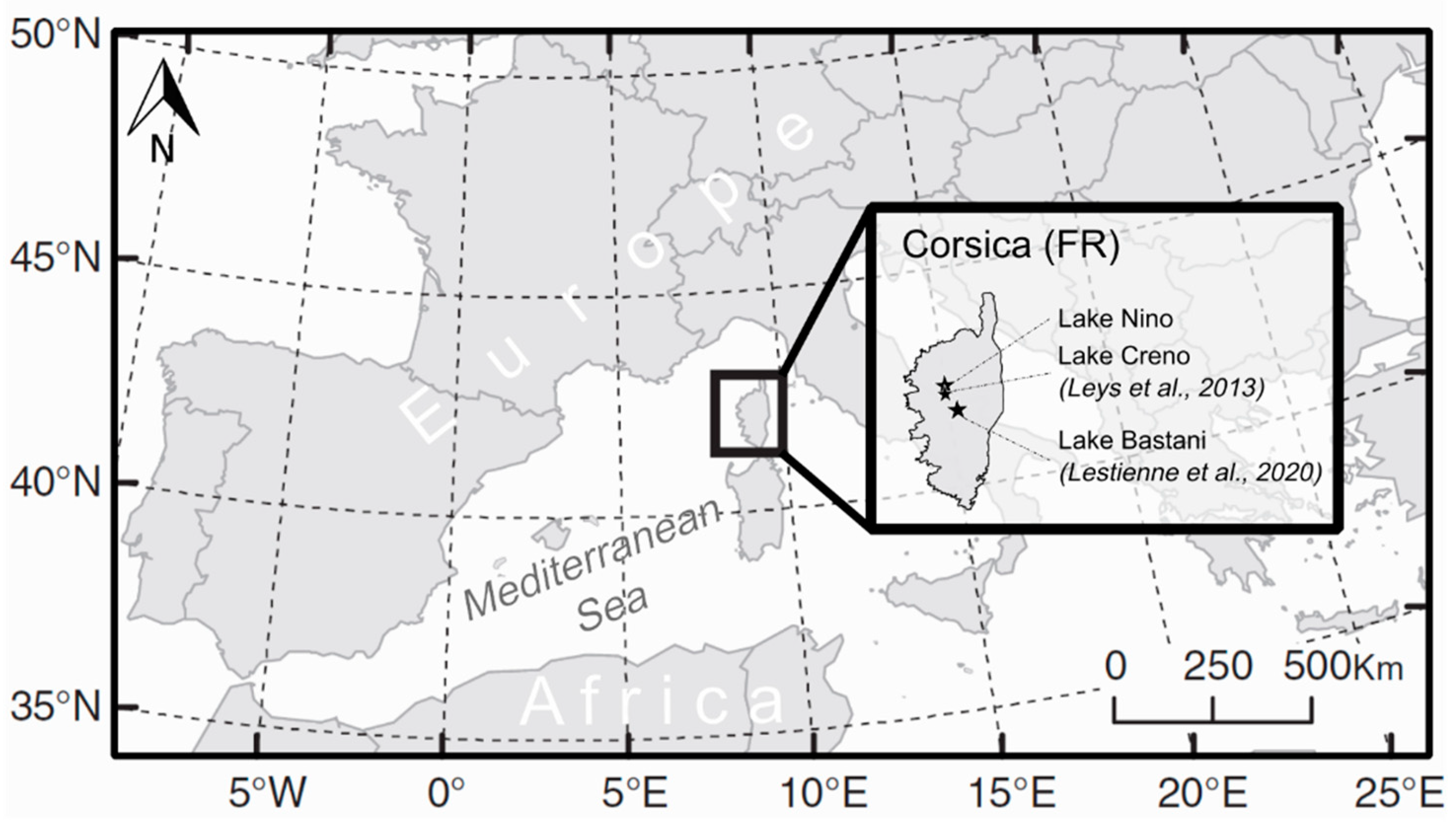
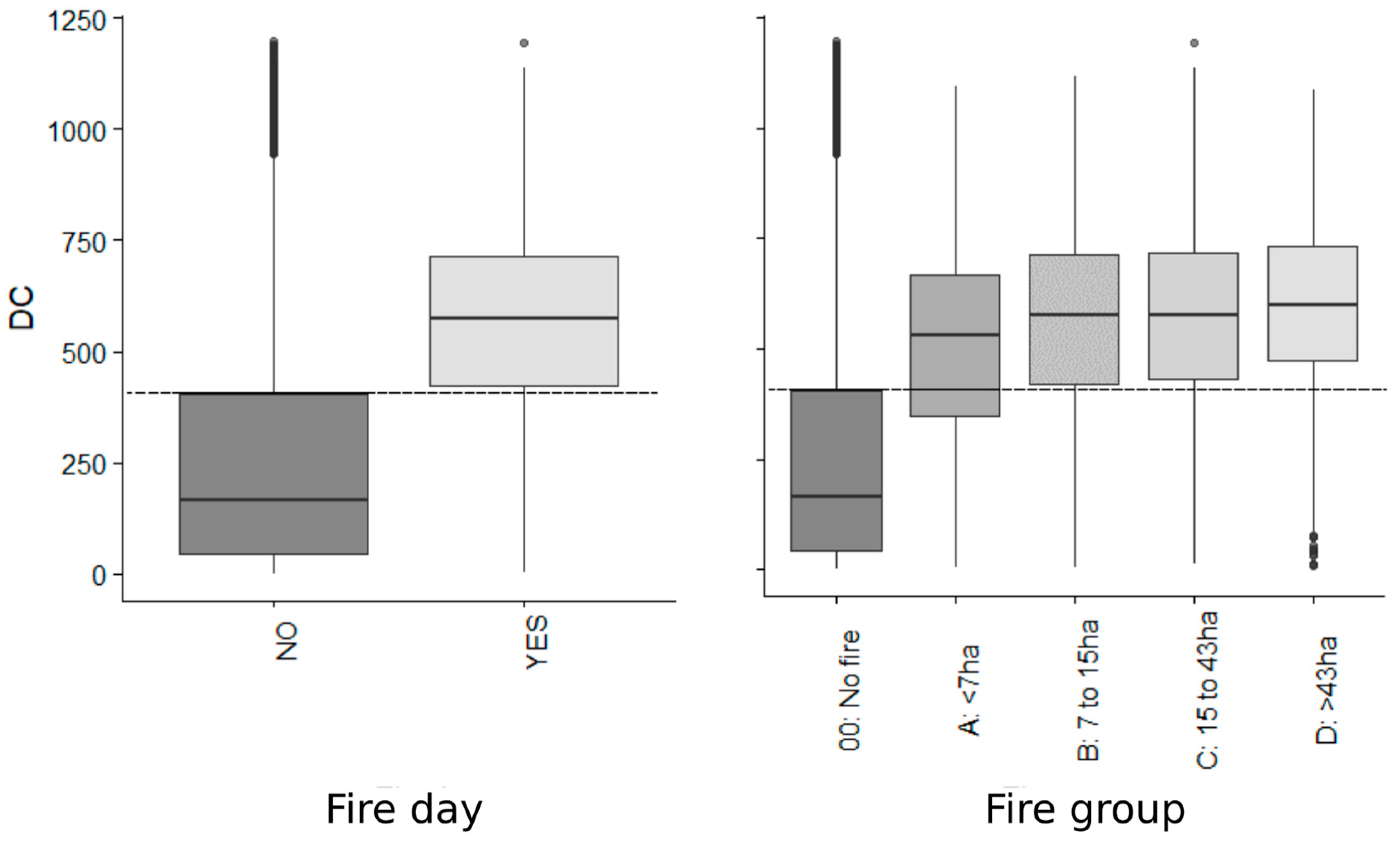
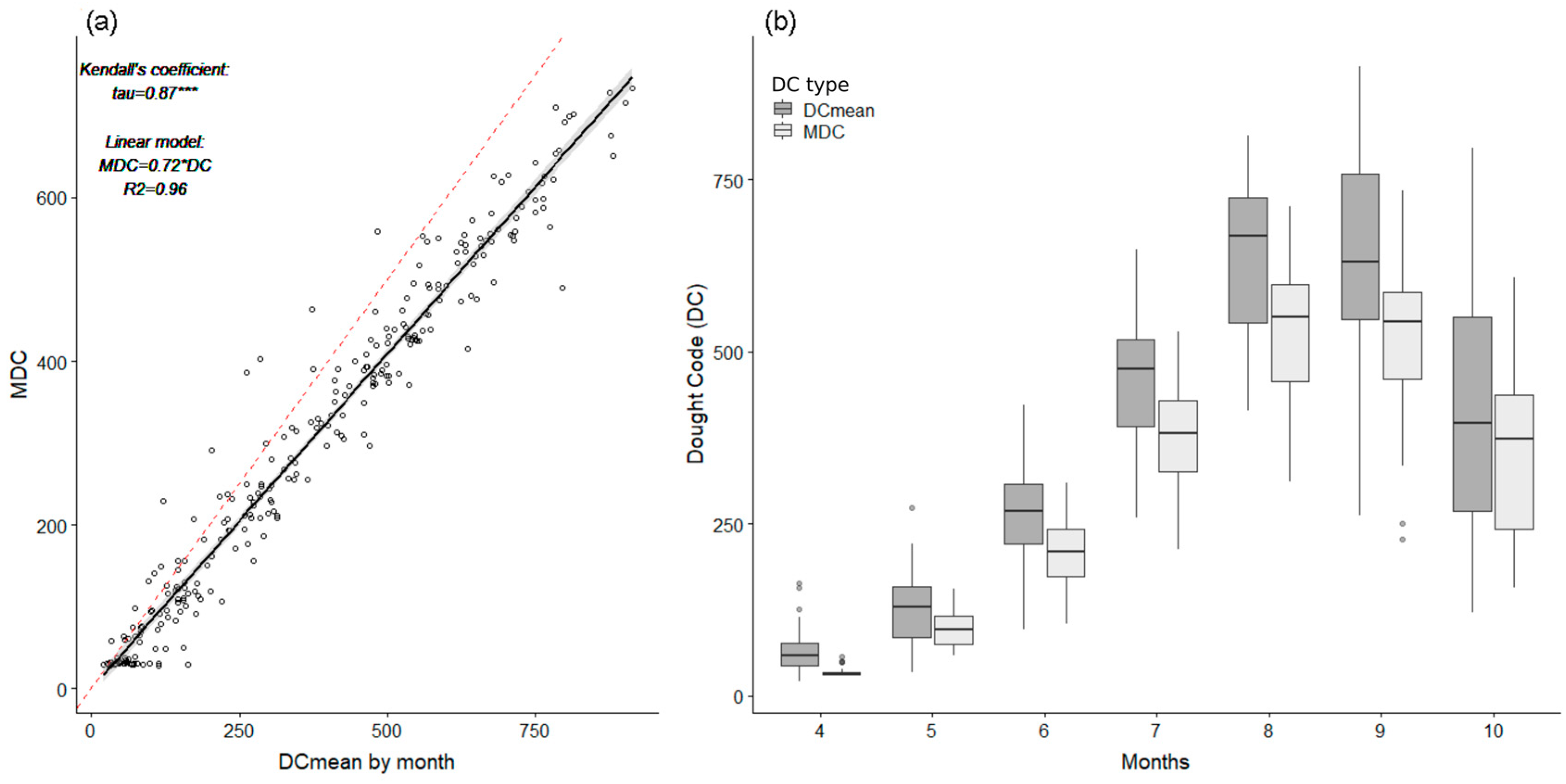
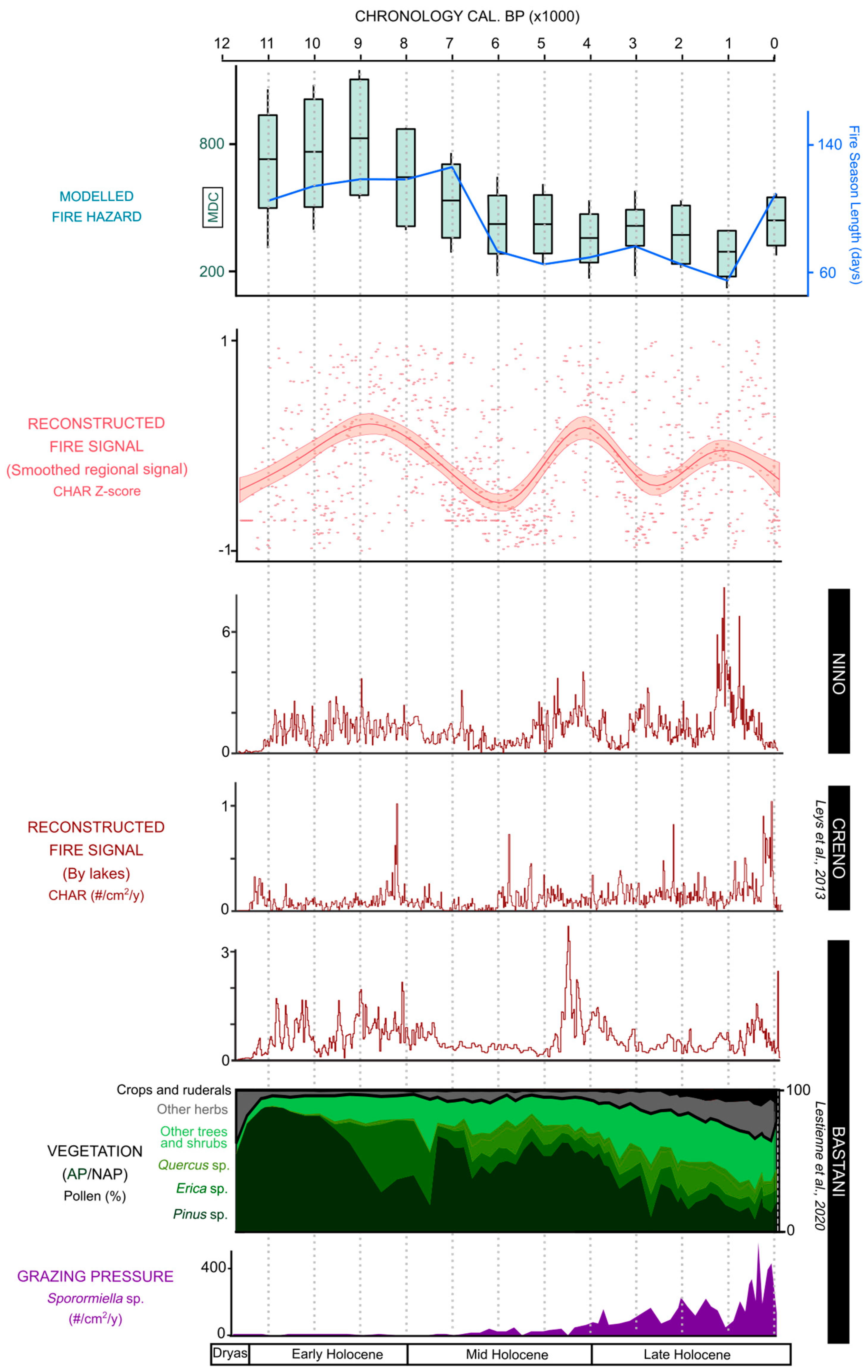
| Dataset | Variable | Unit | Value | |
|---|---|---|---|---|
| Fire regime | Fire frequency | #·year−1 | 84 | |
| Burned area | max | ha | 5644 | |
| median | 10 | |||
| mean | 82 | |||
| Fire Season | month | June to September/October | ||
| Climate data | Mean temperature (temp) | autumn | °C | 16.2 |
| winter | 12.1 | |||
| spring | 20.1 | |||
| summer | 26.4 | |||
| Mean precipitation (prec) | autumn | mm·month−1 | 99 | |
| winter | 57 | |||
| spring | 45 | |||
| summer | 27 | |||
| Relative humidity (rh) | autumn | % | 69.5 | |
| winter | 66.2 | |||
| spring | 54.7 | |||
| summer | 50.9 | |||
| Wind speed (ws) | autumn | km·h−1 | 12.8 | |
| winter | 13.6 | |||
| spring | 11.5 | |||
| summer | 9.7 |
| ka BP | Mean MDC | Fire-Season | ||
|---|---|---|---|---|
| Starting | Ending | Length | ||
| 0 | 419 | 11 June | 2 October | 111 |
| 1 | 314 | 21 July | 15 September | 54 |
| 2 | 379 | 26 July | 30 September | 64 |
| 3 | 394 | 22 July | 9 October | 77 |
| 4 | 365 | 21 July | 1 October | 70 |
| 5 | 412 | 28 July | 4 October | 66 |
| 6 | 406 | 23 July | 5 October | 72 |
| 7 | 482 | 3 June | 9 October | 126 |
| 8 | 556 | 13 June | 10 October | 117 |
| 9 | 685 | 18 June | 16 October | 118 |
| 10 | 628 | 17 June | 10 October | 113 |
| 11 | 598 | 18 June | 4 October | 106 |
© 2020 by the authors. Licensee MDPI, Basel, Switzerland. This article is an open access article distributed under the terms and conditions of the Creative Commons Attribution (CC BY) license (http://creativecommons.org/licenses/by/4.0/).
Share and Cite
Lestienne, M.; Hély, C.; Curt, T.; Jouffroy-Bapicot, I.; Vannière, B. Combining the Monthly Drought Code and Paleoecological Data to Assess Holocene Climate Impact on Mediterranean Fire Regime. Fire 2020, 3, 8. https://doi.org/10.3390/fire3020008
Lestienne M, Hély C, Curt T, Jouffroy-Bapicot I, Vannière B. Combining the Monthly Drought Code and Paleoecological Data to Assess Holocene Climate Impact on Mediterranean Fire Regime. Fire. 2020; 3(2):8. https://doi.org/10.3390/fire3020008
Chicago/Turabian StyleLestienne, Marion, Christelle Hély, Thomas Curt, Isabelle Jouffroy-Bapicot, and Boris Vannière. 2020. "Combining the Monthly Drought Code and Paleoecological Data to Assess Holocene Climate Impact on Mediterranean Fire Regime" Fire 3, no. 2: 8. https://doi.org/10.3390/fire3020008
APA StyleLestienne, M., Hély, C., Curt, T., Jouffroy-Bapicot, I., & Vannière, B. (2020). Combining the Monthly Drought Code and Paleoecological Data to Assess Holocene Climate Impact on Mediterranean Fire Regime. Fire, 3(2), 8. https://doi.org/10.3390/fire3020008





